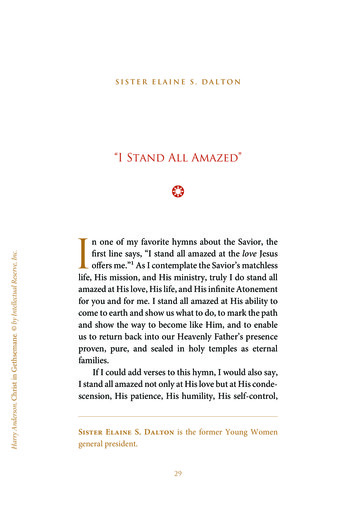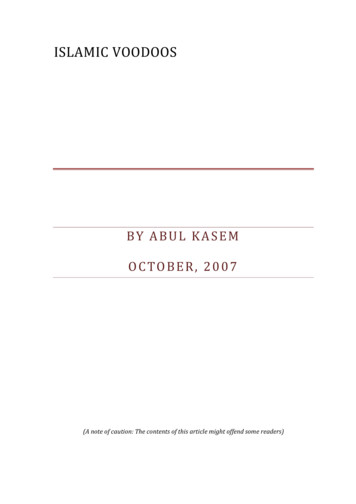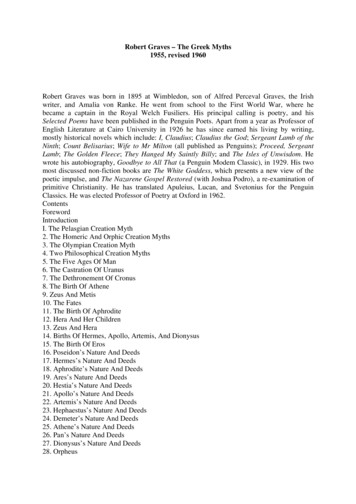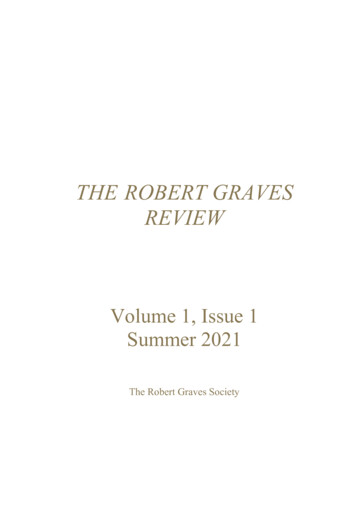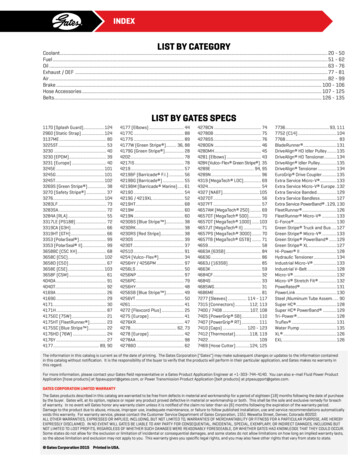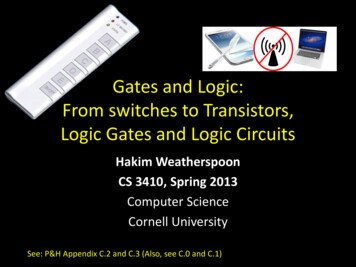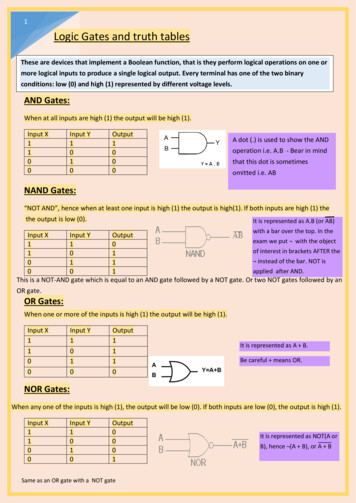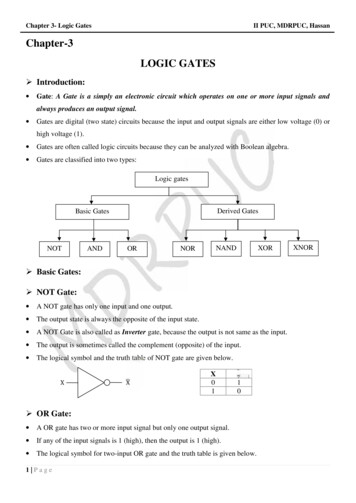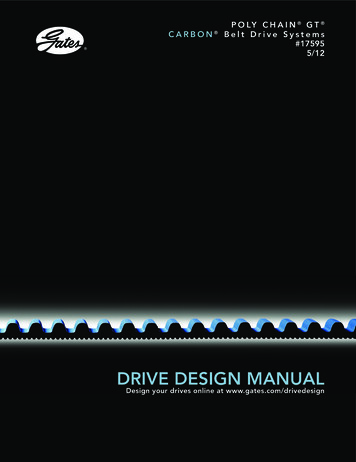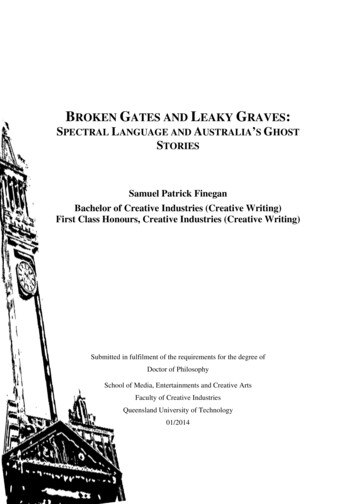
Transcription
BROKEN GATES AND LEAKY GRAVES:SPECTRAL LANGUAGE AND AUSTRALIA’S GHOSTSTORIESSamuel Patrick FineganBachelor of Creative Industries (Creative Writing)First Class Honours, Creative Industries (Creative Writing)Submitted in fulfilment of the requirements for the degree ofDoctor of PhilosophySchool of Media, Entertainments and Creative ArtsFaculty of Creative IndustriesQueensland University of Technology01/2014
KEYWORDSGHOSTS, HAUNTINGS, PARANORMAL FICTION, AUSTRALIAN FICTION,POSTCOLONIALISM, CRITICAL PHILOSOPHYiBroken Gates and Leaky Graves:Spectral language and Australia’s ghost stories.
ABSTRACTBroken Gates and Leaky Graves: Spectral language and Australia’s ghost stories.Ghost stories are unusual amongst supernatural literatures in their modelling of arecognisable, mimetic reality interrupted or infiltrated by immaterial forces. Despite this, thedominant approaches to criticism of the literary ghost story do not address the ghost story interms of its modelled reality. This thesis, in its discussion of Australian ghost stories,advances a new approach to ghost narratives which seeks to model and articulate themechanics of ghosts and hauntings as something reliant on and engaged with the material andthe mundane. This approach is termed spectral language is grounded in the philosophicalwork of Martin Heidegger, Walter Benjamin and Ludwig Wittgenstein and is attuned to thefictive, folkloric and cultural logic that allows the ghost and haunting entry into the otherwiserigorously ‘real’ reality of the text.A spectral language reading of Australia’s corpus of ghost literature, including works byauthors such as Mudrooroo, Tim Winton, Lucy Sussex, Christos Tsiolkas, Carmel Bird andSam Watson, reveals an Australia perpetually troubled, but also reassured by a dynamic andcontinually shifting language of memory, haunting and ghostly presence.iiBroken Gates and Leaky Graves:Spectral language and Australia’s ghost stories.
TABLE OF CONTENTSKeywordsiAbstractiiTable of ContentsiiiStatement of Original AuthorshipivAcknowledgementsvIntroduction1Chapter One:Stained and Fertile Soillandscape, history and ‘Gothic Australianness’31Chapter Two:Fractured Bodies and Fracturing Narratives violence, monsters and traumatic tales61Chapter Three:Red Heart/Black Spiritindigeneity, the colony and spectral property93Chapter Four:A Troubled Mediumutterance, story-tellers and the tyranny of text133Chapter Five:A Cult of Gravesmonuments, architecture and concreted identity175Chapter Six:The Cussed Junkyardreproduction, bricolage and the machine213Conclusion251Bibliography273iiiBroken Gates and Leaky Graves:Spectral language and Australia’s ghost stories.
STATEMENT OF ORIGINAL AUTHORSHIPThe work contained in this thesis has not been previously submitted to meetrequirements for an award at this or any other higher education institution. To the best of myknowledge and belief, the thesis contains no material previously published or written byanother person except where due reference is made.Signature:QUT Verified SignatureDate:29/04/2014ivBroken Gates and Leaky Graves:Spectral language and Australia’s ghost stories.
ACKNOWLEDGEMENTSI wish to express my sincere gratitude to my supervisor Dr. Lesley Hawkes. Beyond supervision, shealso gave me the full trust and support I needed to undertake this project, steering me towardstheorists, theories and concepts without which this project could not have been completed. Over theseven years I have spent at QUT, she has been a continued inspiration and guiding light. I would alsolike to thank Dr. Vivienne Muller, whose insight and critical eye curtailed my excesses and withwhich I could not have done without.To Imogen Smith, Sarah Kanake, Mark Piccini and the HDR Creative Writing and Literary Studiescohort as a whole thank you for your collegial support as well as for the free and frank exchange ofideas and the simple pleasures of kvetching about the academic process. I would like to acknowledgethe contributions of my friends and family, for their support and near limitless patience with anoccasionally moribund and obtuse topic.Finally I would like the acknowledge the contribution of the Australian Government with whosefunding I was able to devote my full time and energy to the completion of this project.vBroken Gates and Leaky Graves:Spectral language and Australia’s ghost stories.
viBroken Gates and Leaky Graves:Spectral language and Australia’s ghost stories.
INTRODUCTION“No disembodied spirit can resist an open medium like moths to a flame they come”-Traci Harding, ‘The Detox Factor’Australia is haunted. Its architecture and its literature are shadowed and penetrated by theunquiet dead. In some ways this haunting is well known: tacitly acknowledged in Australia’s‘guilt industry’ and implicit in the anxieties and ambivalence surrounding Australian identity.As with many other nations, it is a rare historical site in Australia that does not claim someform of haunting or other. Ghosts also weave in and out of Australia’s media, both canonicaland contemporary dragging with them a rhetoric of dread, debt and historical troubles. TheAustralian cultural climate, in this sense, is a haunted one. In its short history as a ‘settled’nation, it has more than earned this haunting. Where the injustices of the colonial system go,the ghosts of the wronged follow and intermingle with other ghosts which seem to throngwherever people live: the ghosts of suicides, infanticides, murders and deaths by deprivation.As such tables rattle, lights flicker, graves glow and apparitions are glimpsed in the mirrorsand corridors of old colonial houses. These are the physical signs that Australia is haunted,and the means by which its citizens detect the dark histories which underlie its colonisationand continued settlement. Taken in isolation, these signs, however, are arbitrary: little morethan random and occasionally entirely mundane phenomena.The system of signs and phenomena that constitute a ghostly or haunting encounterare not empirically obvious: rather they are an inherited cultural language. The significanceof rattling, flickering and so on are learned rather than intuited. Given the scepticism whichgreets claims of real ghostly encounters, at least within the rationalised and empiricised1Broken Gates and Leaky Graves:Spectral language and Australia’s ghost stories.
‘West’, this information is no longer imparted seriously, or with deliberate intent. Thisinformation is absorbed from a media environment that indulges regularly in the fiction orpotential of ghostly experience and encounter: educating audiences in a cultural logic thatgoverns the ghost and the haunting, As the ghost story must be central to this kind ofeducation, it is curious that there has been only limited engagement with the structures andmechanics of the form which operate according to this cultural logic. While the form hasoften been plumbed for its psychological or ideological weight, less attention has been paid tothe underlying logic that is recognisable in ghost stories across media: a logic shared,developed and informed by folklore, urban legends, mass media and literary ghost stories.Because of the instrumentality of this logic, it can be said that Australia is haunted because ofits stories. It is the narrative that transforms a rattling table, a flickering light and themomentary impression of a woman at the window into something more than coincidence. Itis a story that calls the ghost into the wail of wind through the gapped walls of a homestead,or articulates the sense of discomfort and dread that hangs over massacre sites, marked orunmarked.What makes the supernatural logic of the ghost story intriguing is its ability toembrace the real world and its concerns not only metaphorically, but mimetically. Instead ofembodying, by way of metaphor, the types of concerns signalled above the ghost andhaunting are responses to those concerns; they articulate rather than represent guilt,unsettlement or dark histories. The ghost story in this thesis is a narrative defined by thatmimetic engagement. It is a form which models a mimetic reality, and which invests thematerial, objectively present elements of that world with paranormal significance, agency orpresence. While not framed in those terms, this quality is recognised by both authors andcritics of the ghost story as essential. Michael Cox and R.A. Gilbert argue in theirintroduction to The Oxford Book of English Ghost Stories that ‘we must feel this imagined2Broken Gates and Leaky Graves:Spectral language and Australia’s ghost stories.
world to be in its essentials a reflection of our own, making us anxious witnesses to a suddenand often fatal violation of everyday reality by the supernatural’(Cox and Gilbert 2008, p. x).This mimetic effect means that any instance of a ghost text will be informed by the tropes,logic and trappings of ghost texts from other media, and forms of storytelling. This results ina hybridised language borrowed and developed across the fields that the ghost story emergesin rather than discrete folkloric, filmic, or literary heritages. Each of these individualheritages partakes in an ‘everyday reality’ which contains the narratives and tropes of theothers. Inexorably, ghosts have crept into Australian culture invading the text of novels, shortstories, poems, plays, films and all manner of cultural texts and practices. Despite this,Australia’s ghost stories have received relatively little critical attention. Broken Gates andLeaky Graves seeks to write into that lack, asking what is this material language of hauntingwhich makes immaterial and intangible narratives and presences present, and what do thetropes of this language reveal about Australian ghost stories?It should be noted here that this thesis, while aware of the wide field that ghost storiesemerge in: a field that includes oral culture, mass-media and folklore, it is principallyconcerned with, and takes its subjects from literary ghost stories. The reasons for this aretwofold. Firstly, the ghost story remains, despite the diversity of ghost narratives, roughlysynonymous with the short, self-contained narrative advanced by ‘masters’ of the form suchas M.R. James, Sheridan Le Fanu and Algernon Blackwood. Secondly, written narrativefiction evades the problems raised by musical cues, special effects or framing techniques inregards to the work’s common, mimetic reality. Written ghost stories are also closer, in theiruse of language, to oral or folkloric ghost stories than these other mediated forms whichincorporate auditory landscapes, musical cues, and visual effects.3Broken Gates and Leaky Graves:Spectral language and Australia’s ghost stories.
Explorations of the ghost are not unknown within academia, nor within the field ofliterary studies specifically. However, previous discussions of the ghost have been containedeither within single subject approaches, or otherwise favoured psychoanalysis, hauntology,literature or film to the exclusion of the rich, cross-fertilised, hybrid influences andconstructions that inform the tropes and logics of any given iteration of a spectral text. Thisthesis provides a method of reading ghost texts that can synthesise and respond to the rangeof research already undertaken on the ghost story without disregarding or abandoning themimetic realism of the form. It would be impossible to fully trace or catalogue the seeminglyinexhaustible array of spectres and spirits that have been said to dwell in Australia, or todisentangle the various traditions that underpin Australian ghost stories and hauntingaccounts. Instead, this work concerns itself with the narrative methods which render the ghostvisible and sensual within the written Australian ghost story: in short, the mechanics ofrepresentation and embodiment which underpin narratives of spectral engagement. For thisreason, rather than deal exclusively with the loaded (and cultural determinate) terms ofghosts, hauntings, revenants and so on Broken Gates and Leaky Graves defines whatunderlies these – a concept of spectrality and the spectral.As terms spectral and spectrality have become widely used within a section of thehumanities interested in the subjectivity of experience, suffering or identity. According toMaria del Pilar Blanco and Esther Pereen in their introduction to The Spectralities Reader(2013) this usage is largely accepted to have been inaugurated by Jacques Derrida’s 1993Spectres of Marx. Derrida’s usage set the spectral against the conventional and thetaxonomic:A traditional scholar does not believe in ghosts – nor in all that could be called thevirtual space of spectrality. There has never been a scholar who, as such, does notbelieve in the sharp distinction between the real and the unreal, the actual and theinactual, the living and the non-living, being and non-being [.], in the opposition4Broken Gates and Leaky Graves:Spectral language and Australia’s ghost stories.
between what is present and what is not, for example in the form of objectivity.(Derrida 1994, p. 11)For Derrida spectrality is a virtual space that denies and evades standard systems ofknowledge and inquiry. The ghost, to Derrida, cannot be known as it is: ‘at once arbitrary andimpossible: one can neither classify nor count the ghost’ (ibid p. 138).Del Pilar Blanco and Pereen map the appeal of the terms spectral and spectrality toscholars both directly and indirectly influenced by Derrida’s adoption of the subject:“Spectre” and “spectrality” not only have a more serious scholarly ring to them [thanghostly], but specifically evoke an etymological link to visibility and vision, to thatwhich is both looked at (as fascinating and spectacle) and looking (in the sense ofexamining), suggesting their suitability for exploring and illuminating phenomenaother than the putative return of the dead.[.]In their new spectral guise, certain features of ghosts and hauntings – such as theirliminal position between visibility and invisibility, life and death, materiality andimmateriality, and their association with powerful affects like fear and obsession –quickly came to be employed across the humanities and social sciences to theorize avariety of social, ethical, and political questions. (del Pilar Blanco and Pereen 2013a,p. 2)Derrida, and theorists who follow Derrida, apprehend the ghost and haunting as a similerather than as an object of inquiry. The amenability of spectrality to the academy, its‘scholarly ring’, is tied to a usage that is evocative rather than definitional: a literal eliding ofthe ghost that underlies its ghostliness. While this approach has its uses within the humanitieswhere it is commonly found, it is only of limited use to direct discussions of the literary ghostand haunting. The term becomes dislocated from its origin point. In effect, the spectralbecomes synonymous with the ghost-like rather than the ghostly. While this shift may seemminor, it is worth remarking that while the ghost may be described as ghostly (albeitsomewhat tautologically) it cannot be described as ghost-like. As del Pilar Blanco and Pereen5Broken Gates and Leaky Graves:Spectral language and Australia’s ghost stories.
outline, the ‘expansive adoption of the spectre as able to (re)configure fundamental aspects ofour culture and existence [is] always perilously close to overstretching the concept andignoring local variations in the way ghosts and haunting are apprehended and employed’ (delPilar Blanco & Pereen 2013b, p. 35).Derrida’s writing does, in some of its specifics, echo the descriptions attached toghosts and hauntings that will be found throughout the thesis, and in the language of theoristsand scholars who are quoted or referenced throughout. Derrida’s deployment of spectralterms and hauntology has no interest in the ghost or haunting as subject. For Derrida, and forthe theorists who follow on from Spectres of Marx, the ghost is a tool for reading with, ratherthan a subject to be read or theorised in its own terms. To this end, the Derridean approachselects and extends those ghostly qualities which best serve its purpose while suppressingthose conservative, ideological or culturally specific aspects of the ghost which do not meshwith spectrality as unclassifiable. As del Pilar Blanco and Pereen write ‘[Derrida] uses thefigure of the ghost to pursue (without ever fully apprehending) that which haunts like a ghostand, by way of this haunting, demands justice or at least response’ (del Pilar Blanco andPereen 2013a, p. 3). In approaching those things which are like a ghost Derrida does notaddress the spectre as it exists fictively. Colin Davis in ‘Hauntology, Spectres and Phantoms’(2005) argues that: ‘Derrida’s spectre is a deconstructive figure hovering between life anddeath, presence and absence, and making established certainties vacillate. It does not belongto the order of knowledge’ (Davis 2005, p. 376). The ghost may appear to underminebinaries, and as such, to trouble existing categories of knowledge. However the fictive andfolkloric figure of the ghost is culturally determinate, and is ‘known’ according to literary andfolkloric traditions.6Broken Gates and Leaky Graves:Spectral language and Australia’s ghost stories.
Roger Luckhurst highlights the limits of the Derridean ‘hauntology’ especially whenconfronting the deeply invested and specific topographies that surround, and interpenetratethe discourse of ghosts, hauntings and the paranormal. Hauntologies are positioned inbetween, they vacillate between life and death, presence and absence and as such ahauntological approach can sketch out the culturally determinate grounds of the haunting andthe ghost only abstractly. Writing of the spectral turn as ‘the critical language of spectral orhaunted modernity that has become cultural-critical shorthand in the wake of [JacquesDerrida’s] Spectres of Marx’ (Luckhurst 2002, p. 534), Luckhurst argues that even as thehauntology is sympathetic to a reading of a ghostly and ghosted reality this shorthand can:‘only go so far in elaborating the contexts for the specific topography of London Gothic –that, indeed, the generalised structure of haunting is symptomatically blind to its generativeloci’ (ibid). While Luckhurst is interested only in the specific context of what he terms theLondon Gothic, his claims extend to the blindness of Derridean approaches to all specificcontexts and loci. What this blindness results in is a post-Derridean eye to which ‘no concept,no self-identity, no text, no writing [ ] is not haunted’ (Luckhurst 2002, p. 535).Derrida and other theorists within the spectral turn are not blind to the features orqualities of the ghost. For the most part, however, they are not interested in the mechanics ofthe ghost. Rather, many of the writers who use the terminology of spectrality, haunting or thehauntology specifically are often uninterested in the ghost itself. By ‘ghost itself’ is meant theghost as it would be understood from folklore or ghost stories rather than as a poetic orallusional figure. For the above reasons, it is clear that the pre-existing uses of spectrality andthe spectral, while compelling in their capacity to extend into the space between purelyliterary investigation and historical or sociological fields, cannot articulate the mechanics ofthe ghost story as it is formulated around the ghost and ghost-like as a tool for, rather thanobject of analysis. This reinforces the need for a new approach which reclaims the language7Broken Gates and Leaky Graves:Spectral language and Australia’s ghost stories.
of the spectre to examine and explore the ghost and haunting whose narratives and literaryworks are part of the ‘generative loci’ to which Derrida’s approach is specifically blind. Thisapproach would necessarily be grounded in a conception of the ghost as real, or potentiallyreal rather than a purely figurative, or metaphorical presence within texts. A conception thatlike the Victorian’s figurative ghost described by del Pilar Blanco and Pereen ‘remain[s]grounded, to an extent, in the ghost’s possible reality as an empirically verifiable supernaturalphenomenon, making it less a tool for obtaining insight into something else than itself anobject of knowledge’ (del Pilar Blanco and Pereen 2013, p. 3).The use of the spectral within this thesis refers explicitly to the presence of theimmaterial supernatural within a mimetically real, material world rather than the liminalposition used by other critics of the spectral. In order to embrace the mimetic, reality affecton which this enmeshment relies a method of reading is needed which can speak to both thisreality and the rich meaning contained in, and communicated by ghostly fictions. In order todo this, a definition of spectral is advanced that is grounded in philosophy: specifically thephilosophies of Martin Heidegger, Walter Benjamin and Ludwig Wittgenstein. While thespecific borrowings from these philosophers will be explored later, it should be noted thatthis is not intended to render the spectral a philosophical innovation, but to ground theliterary, or fictive investigations undertaken with the concept within a mimetic reality andconsciousness.Within the philosophical framework of this literary investigation the spectral refers toa form of immateriality that it is both active (autonomous) and ‘inner worldly’. It belongs to,and operates within, the material world and not within a transcendent or ‘otherworld’. Also, itis independent of any single individual and exists, at least potentially, outside of theirconsciousness or imagination. This relationship and belonging is expressed in philosophical8Broken Gates and Leaky Graves:Spectral language and Australia’s ghost stories.
terms, as it is philosophy which best allows a negotiation between the many fields of researchwhich focus on the ghost, the structures of realism within the text, and the reality of the worldon which they are modelled. The ‘being’ of ghostly and spectral agents is not fundamentallydifferent than other forms of being, as regards its worldly position. While it may not have anobjective, material existence, spectrality remains anchored to the material world by the sameconnections which connect things which do objectively exist. Martin Heidegger reminds hisreaders in Being and Time (1927) that ‘the world of Da-sein [conscious beings] is a withworld. Being-in is being-with others’ (Heidegger 1997, p. 112). No entity is ever fullyautonomous, being born into, and arising only within a world of objects and other beings. TheDa-sein determines and is determined by the experience and understanding of these otherbeings:The others who are “encountered” [.] in the surrounding world at hand are notsomehow added on in thought to an initially merely objectively present thing, butthese “things” are encountered from a world in which they are at hand for others. (ibidp. 111)The spectral is ‘at hand’ for others, they are not dependent on any particular individual. Ghosttourism, for instance, is motivated by a desire to contact ghosts that are not personal. Ghosts,for all they are immaterial, are still ‘publicly’ accessible, as other objects, to anyone. It istexts which feature this kind of spectrality, of immaterial but materially relevant agents,presences or narratives which are of interest to the thesis.The conception of spectrality outlined above is key to the development of a culturallogic, and means of reading that logic, originated by this thesis. Spectral language is themechanism by which past narratives, histories and personalities continue to erupt into thepresent and become sensible through material reality and tactile sensory impressions within9Broken Gates and Leaky Graves:Spectral language and Australia’s ghost stories.
ghost narratives. The spectral demarcates that which is immaterial but materially relevant –spectral language is the structure and substance of that spectrality’s material articulation.Spectral language is explored in depth over the course of the first two chapters of thethesis, where its particularities and its flexibility are outlined in the practical interpretation ofa number of texts. Rather than attempt to fully explain spectral language prior to this textuallyembedded exploration, this introduction will instead serve to provide some information aboutits philosophical underpinnings and their contribution to a literary investigation. BillHemminger has pointed out that Heidegger offers an understanding particularly useful totheorising animistic texts such as Ben Okri’s 1991 The Famished Road which ‘redefine theworld human beings inhabit and argue[s] for increased interplay between physical andspiritual in a modern technologised world’ (Hemminger 2001, p. 67). As Hemmingeridentifies, Heidegger offers an alternative to anthropocentric models where ghosts, spirits andtheir like are the purview only of humans and their delusions. While Heidegger notes thesignificance of objective presence to ontology, in that one cannot encounter what is notpresent, this objectivity does not presuppose being, nor render it a ‘thing’. As he writes inBeing and Time ‘Da-sein can never be past, not because it is imperishable, but because it cannever be objectively present. Rather, if it is, it exists’ (Heidegger 1997, p. 348). The ghostinhabits a peculiar position, in lacking an objective, material existence as spectral thingsmust, but is still present in and through the references of material things. Using the exampleof a boat, Heidegger explains ‘the boat anchored at the shore refers in its being-in-itself to anacquaintance who undertakes his voyages with it, but as a “boat strange to us,” it also pointsto others’ (ibid p. 111). Ghosts are an implied other, they may be the disenfranchisedresidents or owners of a house, as in Tin Winton’s 1992 Cloudstreet (examined in ChapterThree: Red Heart/Black Spirit), beings who are present in the ‘being-of-itself’ of the house.10Broken Gates and Leaky Graves:Spectral language and Australia’s ghost stories.
In this sense, the ghost of a haunted place is not ‘added on’ but implicit in the nature ofobjectively present things. The phenomena of phantom lights, table rappings, unlocking doorsand other discernible happenings form the references to the ghost who is never fully ‘here’but exists as a reference from that which is at hand and experiential.The ‘at-handedness’ and ‘implied others’ of Heidegger’s writing exist within both anontological and cultural context. What is at hand and what others are implied are not relianton an individual’s understanding. However, these implications and references are more likelyto be detected or understood when they fit with a cultural familiarity or understanding. Forexample, the rappings, lights and so forth referenced throughout the introduction as stockelements of the ghostly happening are clearly cultural properties. The nature of this logic,although more fully mapped throughout the thesis, is worth some discussion. It is tempting tothink of these tropes as historical and outdated superstition, while this is not true that viewdoes hang over spectral language’s construction, particularly in Western literature.In The Rise of Supernatural Fiction (1995) E.J. Clery points out that in the eighteenthcentury supernatural excess could only be excused by ‘exemplary historicism’: ‘rationallyspeaking, ghost and goblins are not true, but when they appear in the literary artefact of pastages, they are true to history, accurate representations of an obsolete system of belief’ (Clery1995, p. 54). In the case of the ghost, if not the goblin, this obsolescence is incomplete. Thebelief in ghosts has been regularly revived in the nineteenth and twentieth century Spiritualistmovement and by the plethora of ghost investigation programs like Most Haunted (20022010). Regardless, for the audience Clery describes, ghosts belonged to history and notfantasy. Rather than a literary invention the ghost story is embedded in reality. As ghost‘culture’ changes, through the Spiritualist movement, oral culture, urban legends, televised11Broken Gates and Leaky Graves:Spectral language and Australia’s ghost stories.
and technological ghost hunting, cross-fertilisation between different national and culturalghost beliefs and ghost stories, the literary ghost story changes as well.Ghost stories rest within both historical and contemporary mimetic realities. Theghost therefore exists ‘within’ the world, rather than outside of it. However, the paranormalshould not, as it can be in Magical Realism, or post-modern fiction, something that isunremarkable and unremarked upon by characters within the fiction. The ‘rules’ of themimetic reality should be clear and chiefly mundane. The paranormal in this case is definedby the transgression of a seemingly mundane reality, even if these transgressions highlightthat reality has never genuinely been ‘mundane’. While this element of the definition isstretched in the third chapter of this thesis to consider fiction which models an IndigenousAustralian supernaturally implicit reality, the distinction is significant. Fiction which does notmodel reality does not embrace the mechanics of the ghost story. Mechanically, the ghoststory attempts to reconcile the supernatural or paranormal with common reality, areconciliation which demands the ghost story base its material manifestations and mediatorsin common and worldly objects. ‘Australian’ ghost stories are not a fundamentally differenttype of literature than ‘transnational’ ghost stories. The discussion above, and the definitionsand limits proposed within, apply equally well to the ghost story as a transnational narrativeform, and to ghost stories within Australia. Rather than propose the Australian ghost story asa distinct literary form, this thesis pursues Australian ghost
Broken Gates and Leaky Graves: Spectral language and Australia's ghost stories. world to be in its essentials a reflection of our own, making us anxious witnesses to a sudden and often fatal violation of everyday reality by the supernatural'(Cox and Gilbert 2008, p. x).
